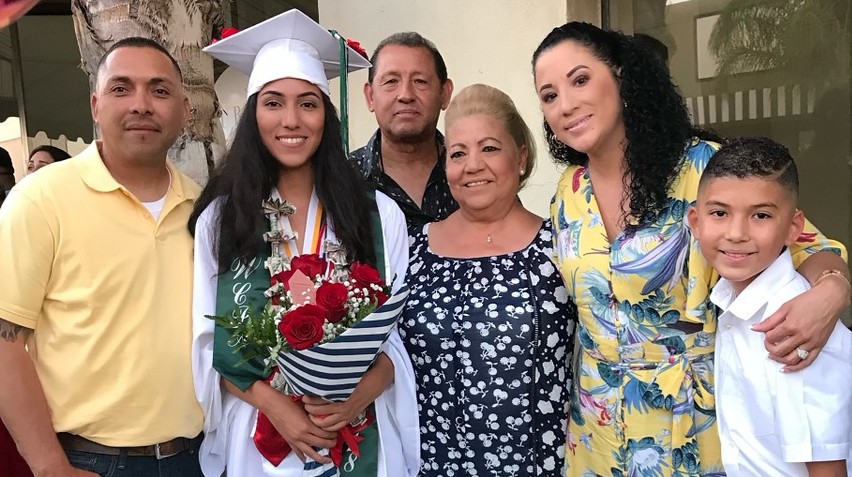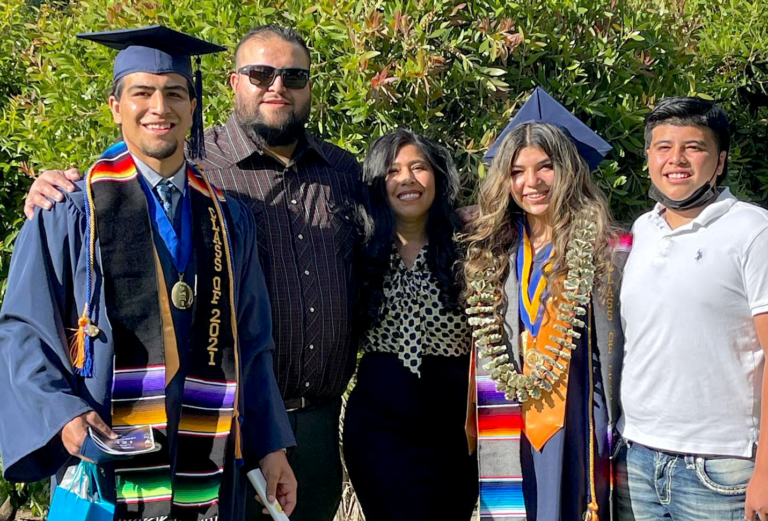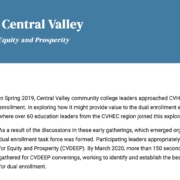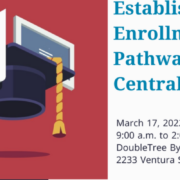Tag Archive for: CVDEEP
CVHEC Dual Enrollment Convening set for March 17 in Fresno
The “Establishing Dual Enrollment Pathways in the Central Valley” convening Thursday, March 17, will bring more than 150 secondary and postsecondary educators together in person for the first time since the pandemic shutdown to address challenges and barriers to dual enrollment success.
Presented by the Central Valley Higher Education Consortium, the convening will be from 9 a.m. to 2 p.m. at the DoubleTree By Hilton Hotel in downtown Fresno.
Registration to participate is now open at: https://bit.ly/DEpathwaysCV (the hotel link is https://bit.ly/DoubleTreeFresno).
This second convening will continue the work started on March 5, 2020 – two weeks before the pandemic shutdown – which resulted in several initiatives that have enhanced the delivery of dual enrollment in the region:
- Improvements in the CCCApply application process to the California Community College system.
- The Dual Enrollment Upskilling Teachers Master’s Program that provides access to state funding through the Fresno K-16 Collaborative providing funds for high school English and math teachers to earn their master’s degrees.
“This unique event — intersegmental collaboration at a regional level — will be highly interactive and will engage audience members with panel presenters from valley colleges and high schools including practitioners and student success stories,” said Dr. Benjamín T. Durán, CVHEC executive director.
This renewed localized promotion of dual enrollment began in Spring 2019 when Central Valley community college leaders approached CVHEC to provide convening assistance surrounding dual enrollment, a strategy that allows secondary school students to earn college credits before their high school graduation.
As a result of the discussions in these early gatherings, the Central Valley Dual Enrollment for Equity and Prosperity (CVDEEP) Task Force was formed with about 60 community college and K-12 educational leaders who deliver dual enrollment services valley-wide.
“These educators endeavor purposefully and strategically in addressing the complexity of dual enrollment to spotlight both challenges and best practices for colleges and high schools in the nine-county CVHEC region,” Durán said.
In June 2020, CVHEC released a 16-page report, “Dual Enrollment in the Central Valley, Working Toward a Unified Approach for Equity and Prosperity;” by former CVHEC Strategies Lead Virginia Madrid Salazar, Esq., that highlights this work and provides a blueprint to strengthen dual enrollment delivery in the Central Valley. (Also, see her blog in this issue: https://bit.ly/CVHECblog-DualEnrollment021822).
Check for updates and event follow-up at the CVDEEP Convening Website
SEE: CVHEC report, “Dual Enrollment in the Central Valley, Working Toward a Unified Approach for Equity and Prosperity” and press release).
- The 2020 CVDEEP Convening
- Updated CVDEEP press release (March 14, 2022)
BACKGROUND
In 2016, a new dual enrollment option was introduced through Assembly Bill (AB) 288, amending Education Code (EC) 76004, and creating the College and Career Access Pathways (CCAP). This legislation enabled more high school students to take college courses taught by college professors on their high school campuses. California AB 30, signed by Governor Newsom in October 2019, expands and protects dual enrollment through 2027.
CVHEC media contact: Tom Uribes • tom@uribes.com • 559.348.3278
SAVE THE DATE: CVDEEP Convening – March 17, 2022
(UPDATE – the CVDEEP Convening has been rescheduled to March 17. Details will be available in the upcoming February issue of the CVHEC e-newsletter).
CVHEC’s Central Valley Dual Enrollment for Equity and Prosperity (CVDEEP) is now planning to re-convene in person Friday, March 17 at the DoubleTree Hotel in downtown Fresno for the first time since the pandemic shutdown two years ago.
Open to secondary and postsecondary educators and community leaders interested in dual enrollment opportunities for high school students.
See details and registration info: https://www.cvhec.org/cvhec-dual-enrollment-convening-march-17/
• See story about the 2020 CVDEEP Convening.
Dual Enrollment Success Stories: Celeste Galvan of McFarland
 Celeste Galván of McFarland and her family celebrated her two degrees earned by the age of 19 thanks to dual enrollment courses through Bakersfield College before Fresno State. Here they pose with her at her high school graduation in 2018. She is now enrolled in CSU Bakersfield’s teacher credential program. All three campuses are CVHEC members.
Celeste Galván of McFarland and her family celebrated her two degrees earned by the age of 19 thanks to dual enrollment courses through Bakersfield College before Fresno State. Here they pose with her at her high school graduation in 2018. She is now enrolled in CSU Bakersfield’s teacher credential program. All three campuses are CVHEC members.
CVHEC Dual Enrollment Spotlight:
Celeste Galván of McFarland
BY TOM URIBES
CVHEC Communications/Media Coordinator
From one end of the valley to the other, the Central Valley Higher Education Consortium continues to spotlight student dual enrollment success stories.
Like Nataly Frias featured in our first story in September, Celeste Galván of McFarland earned an associate degree at age 17 before she even graduated high school, marching alongside thousands of other Bakersfield College students at the commencement ceremony in Memorial Stadium in 2018.
Then just two years later, after transferring to Fresno State, she earned a bachelor of arts degree in Liberal Studies in May and now, at age 19, she is enrolled in the credential program at California State University, Bakersfield while serving an teacher internship at a nearby elementary school. All three institutions are CVHEC members.
In high school, Celeste participated in a Bakersfield College pilot program at the Wonderful College Prep Academy in nearby Delano that provided students with the opportunity to complete an associate of science in agriculture business from BC by the time they graduated from high school.
Before her senior year, Celeste’s family moved to Bakersfield and she chose to stay with her grandmother in McFarland to finish her BC degree work with the Wonderful Academy.
A typical day for Celeste would start at 4 a.m. to get ready for practice with the cross country team, where she took second place at the CIF Central Section Championships in Woodward Park in 2015. After classes, she would stay at the school library as late as 8 or 9 p.m. to finish her college and high school classwork since she didn’t have access to wifi at her grandmother’s house.
Celeste rode that Renegade/Bulldog/Roadrunner spirit through Bakersfield College, Fresno State and back to CSUB.
Romeo Agbalog, president of the Kern Community College District Board of Trustees, wrote in a Bakersfied.com op-ed in January that the success of Celeste and other students prepared Bakersfield College to scale up its model by launching the Early College program in 2019, with the vision of providing a pathway for every high school student in Kern County to earn between 12 and 60 units of college credit before graduation.
“Every incoming freshman at McFarland High School is enrolled in college-level courses alongside their regular classwork, developing the tools for college and career readiness. Today, over 23,000 students have completed a total of approximately 90,000 college credits at 36 high schools across the county” said Agbalog who also noted the program is successful in closing equity gaps.
“Early College has had a 93 percent student success rate across all high school campuses in the last academic year, consistently exceeding BC’s own institution-set standard for student success by 15 to 20 percent,” he wrote. “Most importantly, more than 85 percent of students from rural areas who were in an associate degree completion pathway went to college after high school.”
See Trustee President Agbalog’s column.
Background:
The Central Valley Higher Education Consortium has been playing an increasing role in furthering Dual Enrollment as an equity-driven strategy to reduce disparities in student persistence and completion rates, which is the essence of the CVHEC mission, including
the creation of a task force in 2019, the Central Valley Dual Enrollment for Equity and Prosperity (CVDEEP).
With over 60 education leaders from the CVHEC region, CVHEC’s Central Valley Dual Enrollment for Equity and Prosperity (CVDEEP) Task Force is identifying and establishing the best elements of a sustainable strategy for dual enrollment that is intentional and aligns with Guided Pathways.
Made up of representatives from Central Valley K-12 districts, colleges, and universities, the task force developed a collaborative regional accord on an equitable delivery of dual enrollment, culminating in a Central Valley Higher Education Consortium white paper in July 2020, “Dual Enrollment in the Central Valley.”
This consensus framework document is designed to assist the nine-county region in the advancement of dual enrollment by reviewing where it has been, identifying the bright spots, identifying challenges and working together to develop solutions.
CVHEC efforts focus on policy implementation and delivery of support to faculty and administrators working on these efforts. The work focuses on regional strategic scaling of Guided Pathways; math pathways; corequisite support (AB 705 and EO 110 implementation); California College Guidance Initiative; and dual enrollment as strategies for equity and degree attainment.
CVHEC will continue to highlight stories about dual enrollment students like Celeste and Nataly in its e-newsletter, and social media platforms. Also, a showcase video conveying the value of dual enrollment for all students through the stories of individual valley students is currently in production and due to be released later this fall semester.
For CVHEC media inquiries, contact Tom Uribes at cvheccommunications@mail.fresnostate.edu or text 559.348.3278.
Dual Enrollment Success Stories: Nataly Frias

Nataly Frias and family: parents Anthony and Sabrina, both CSU Stanislaus alumni, are counselors at Modesto Jr. College and Merced College respectively. Older brother Anthony Frias, II, (far left) also took dual enrollment courses and graduated from MC in the spring with Nataly. Younger brother Isaiah, a Turlock High junior, (far right) turned 16 this month and is also taking dual enrollment courses at Merced College.
Dual Enrollment: success stories underscore equity-driven strategy
Reducing disparities in student persistence and completion rates
BY TOM URIBES
CVHEC Communications/Media Coordinator
The Covid-19 pandemic of the past 18 months cast a shadow over joyous occasions like graduation events for Class of 2020 and 2021 high school and college students everywhere, but one narrative emerged repeatedly in the Central Valley that provided a spark of optimism for our region’s college attainment rates: dual enrollment success stories.
One of those stories is 18-year-old Nataly Frias, who, during her pandemic senior year at Turlock High School (2020-21), had taken enough Merced College courses online to earn two associate degrees in May, even before receiving her THS diploma in June.
Like other students around the country over the years, California students such as Nataly have taken college-level courses while still completing their high school degree thanks to various options such as concurrent or dual enrollment.
“Recent legislation has opened the gates for far more students to take advantage of dual enrollment,” said Saundra McGlothlin, CVHEC’s central regional coordinator and dual enrollment lead “The CVHEC region is committed to stay engaged in developing solutions to overcoming persistent barriers to equity.”
Born to teen parents who themselves worked hard and returned to college (Stanislaus State alums Anthony and Sabrina Frias who are now counselors at Modesto Jr. College and Merced College respectively), Nataly is now enrolled at Fresno State for a bachelor’s degree in Psychology but with her sights set on the Nursing Program.
“Just do it,” Nataly said in a media account about her success and the challenge of dual enrollment courses. “It’s a lot of hard work but you’ll feel so accomplished.”
The pandemic actually had a silver-lining in that she had more time during the quarantine to focus on schoolwork.
“I probably wouldn’t have graduated as early without the pandemic because it really helped give me so much time where I was only focused on my online courses,” said Nataly who said she comes from a “dual enrollment family.”
Her older brother Anthony also took dual enrollment courses when he attended Turlock High and graduated from Merced College with Nataly last spring but is now enrolled at Modesto Jr. College where he plays football. And younger brother Isaiah, a Turlock High junior, is currently taking dual enrollment courses thorough Merced College.
McGlothlin, who retired in 2017 as the vice president of Student Services for West Hills Community College – Coalinga, noted that not all students follow Nataly’s accelerated path of earning an associate degree while in high school. Many take just a few dual enrollment courses that help them get some college credit under their belt while providing a glimpse of the higher education academic curriculum.
“Most of dual enrollment students complete 12-24 units,” said McGlothlin. “This means — in addition to meeting graduation requirements — less money spent when working towards a degree in college, usually a semester or two free.”
See Nataly’s story in local news media accounts:
https://sacramento.cbslocal.com/2021/05/21/turlock-teen-graduates-high-school-college/
Background:
The Central Valley Higher Education Consortium has been playing an increasing role in furthering Dual Enrollment as an equity-driven strategy to reduce disparities in student persistence and completion rates, which is the essence of the CVHEC mission, including
the creation of a task force in 2019, the Central Valley Dual Enrollment for Equity and Prosperity (CVDEEP).
With over 60 education leaders from the CVHEC region, CVHEC’s Central Valley Dual Enrollment for Equity and Prosperity (CVDEEP) Task Force is identifying and establishing the best elements of a sustainable strategy for dual enrollment that is intentional and aligns with Guided Pathways.
Made up of representatives from Central Valley K-12 districts, colleges, and universities, the task force developed a collaborative regional accord on an equitable delivery of dual enrollment, culminating in a Central Valley Higher Education Consortium white paper in July 2020, “Dual Enrollment in the Central Valley.”
This consensus framework document is designed to assist the nine-county region in the advancement of dual enrollment by reviewing where it has been, identifying the bright spots, identifying challenges and working together to develop solutions.
CVHEC efforts focus on policy implementation and delivery of support to faculty and administrators working on these efforts. The work focuses on regional strategic scaling of Guided Pathways; math pathways; corequisite support (AB 705 and EO 110 implementation); California College Guidance Initiative; and dual enrollment as strategies for equity and degree attainment.
CVHEC will continue to highlight success stories like Nataly’s in its e-newsletter, and social media platforms. Also, a showcase video conveying the value of dual enrollment for all students through the stories of individual valley students is currently in production and due to be released later this fall semester.
‘Dual Enrollment Upskilling Teachers Master’s Program’ Advances Equity
An innovative master’s degree program is underway to incentivize dual enrollment delivery at Central Valley high schools with the “Dual Enrollment Upskilling Teachers Master’s Program in English and Math.”
This approach addresses an equity concern raised by the Central Valley Dual Enrollment for Equity and Prosperity (CVDEEP) Task Force that was convened by the Central Valley Higher Education Consortium (CVHEC) in March 2020 when educators asserted that not enough Central Valley teachers are available to teach dual enrollment resulting in fewer opportunities for students – an equity gap.
“Although dual enrollment has been a tool for students to get ahead for college, not every student has been exposed to its benefits and still others who may not view themselves as ‘college material’ lose out on the benefits of its early exposure,” said Dr. Benjamin Duran, executive director of CVHEC. “By broadening dual enrollment opportunities for both rural and urban students, where they didn’t previously exist, more students are able to develop their collegiate confidence.”
CVHEC decided to tackle this equity issue head on when the Fresno K-16 Collaborative made funding available to its local partners. The Fresno K-16 Collaborative is the recipient of a $10 million investment Governor Gavin Newsom announced at the November 2019 California Economic Summit with the intent that the program will take innovative approach to improve student experience and create opportunities for success. Duran said dual enrollment is an effective strategy to help Central Valley students accelerate their college learning.
“Dual Enrollment is key to student access, success and equity. The reality is that dual enrollment only works when students can participate,” said Duran.
CVHEC received grant funding from the Fresno K-16 Collaborative for the Dual Enrollment Upskilling Teachers Master’s Program for English and Math in partnership with CVHEC-member institutions National University and Fresno Pacific.
CVHEC is coordinating two grants: one that is specifically for K-16 Collaborative partners in the Fresno area and a second one that allows for an expanded regional reach. In all, teachers from Fresno, Madera, Merced, and Kings counties will benefit from the Dual Enrollment Upskilling Teachers Master’s Program for English and Math 1.0 and 2.0.
“CVHEC’s two Dual Enrollment Upskilling Teachers Master’s Programs meet the Fresno K-16 Collaborative’s accessible equity-focused mission of creating an integrated, replicable, regional K-16 educational system foundation to address race equity and inclusion of our most vulnerable student populations,” said Karri Hammerstrom, executive director of the Fresno K-16 Collaborative.
This teacher upskilling program serves as a model to scale the program throughout CVHEC’s nine-county region as funding becomes available.
“CVHEC’s mission in all of our work is to create scalable innovations among our intersegmental higher education member institutions,” said Duran. “Although we are starting with a smaller scaled region, our commitment is to scale this program to all nine-counties as soon as we are able.”
The first cohorts of master’s degree students began their studies the first week of January 2021 and the second round of cohorts will begin in May 2021.
Students will have tuition supplemented, in some cases books will be paid for as well and students participating will be paired with college instructors from State Center Community College District who will serve as mentors. In total, the Upskilling Teachers Master’s Programs (1.0 and 2.0) provide for 115 teachers to participate in the program.
About CVDEEP
In Spring 2019, Central Valley community college leaders approached CVHEC to provide convening assistance surrounding dual enrollment that led to a gathering in July 2019 where over 60 education leaders from the CVHEC region began exploring the issue in follow up sessions.
From those convenings, CVHEC created the Central Valley Dual Enrollment for Equity and Prosperity (CV DEEP) Task Force consisting of Central Valley colleges and K-12 partner district educators collaborating to develop a strategy for effective dual enrollment programs regionally.
In March 2020, CVHEC held a comprehensive convening of the CVDEEP taskforce where over 100 community college and K- 12 partners gathered to share best practices, identify ongoing challenges and propose viable solutions.
“One of the top challenges that emerged is the need for more instructors qualified to teach college math and English to meet the increased demand for course offerings in dual enrollment (DE) programs,” said Virginia Madrid-Salazar, CVHEC strategies lead who developed a white paper documenting the organization’s DE initiatives and providing the foundation for the master’s attainment program proposal: “Dual Enrollment in the Central Valley: Working Toward a Unified Approach for Equity and Prosperity”.
“The most desired solution was a partnership with universities for streamlined programs so that interested high school faculty could earn their master’s degree in these two high-need disciplines,” she said. “This would enable them to meet the minimum qualifications set forth by the State Chancellor’s office required to teach college-level courses and providing this opportunity for students as part of their regular high school instructional day.”
CVHEC is a one of 15 Collaborative Partners that comprise the pilot Fresno K-16 Education Collaborative established in 2020 with funding by California Governor Gavin Newsom, reporting to his Council on Post-Secondary Education, to develop four dual enrollment-related educational pathways that help Fresno-area students move from high school to college and into the workforce.
“The outcomes from the ongoing dialogue between community colleges and their K-12 partners in the valley will continue, as will advocacy efforts, to institutionalize dual enrollment as a strategy,” Duran said. “A strategy to blur the lines between high school and community college for those students who can benefit from taking college courses and get a leg up on their quest for a college degree or certificate.”








